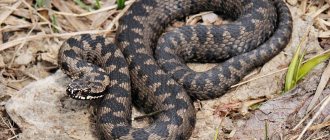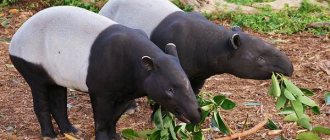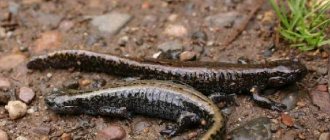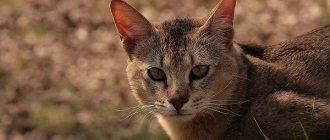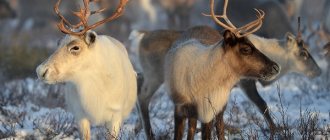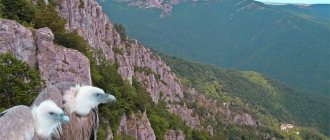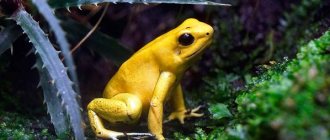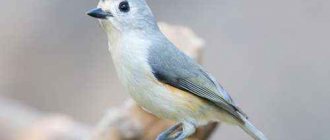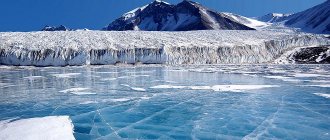The point where the Earth's rotation axis intersects its surface is known as the Geographic North Pole. Unlike the South Pole, the North Pole is not located on a permanent continental mainland. It is located in the vastness of the Arctic Ocean, where the water is almost constantly covered with ice. Winter temperatures in and around the North Pole range from -50 to -13° C. In summer, temperatures hover around freezing. The sea ice in this region is about 2-3 m thick. Thus, given these extreme conditions, there is little diversity of wildlife in the region.
Our knowledge of the animals of the North Pole is based on observations and records of those people who dared to conquer the dangerous Arctic ice and went there on specially designed ships.
White or polar bear
We all associate the polar bear (Ursus maritimus) with the Arctic region. This large, white, carnivore's range is concentrated primarily within the Arctic region. However, although the name of these bears includes the word "polar", they were not previously expected to travel beyond 82° north latitude. However, in 2006, an expedition by a group of Greenpeace activists and researchers proved the opposite. During the mission to reach the North Pole, to their utter surprise, the team encountered a polar bear just 1 mile from the Geographic North Pole. When the bear approached the team's tent on Arctic sea ice at 4 a.m., researchers were able to distract it. According to them, the animal turned out to be not aggressive, but very curious in nature. The presence of seals in the polar region where the bear was spotted may explain how it managed to survive 885 km from the nearest land.
bowhead whale
Marine mammal of the suborder baleen whales. It is also called the polar whale. The maximum body length of a bowhead whale is 22 m. An adult animal usually weighs from 75 to 100 tons. The average life expectancy of a bowhead whale is about 40 years. It dives to depths of up to 200 m and can stay underwater for 40 minutes. Bowhead whales feed on plankton, consuming more than 1.5 tons of it daily.
polar fox
The Arctic fox (Vulpes lagopus) is a typical inhabitant of the Arctic. These animals are found in coastal, inland and alpine tundra regions of Eurasia, Iceland, Greenland and North America. The Arctic fox was discovered less than 60 km from the North Pole, at 89°40′ N latitude. These animals are opportunists and will eat almost anything, including berries, bird eggs, small mammals, fish, large mammal carcasses, etc. Due to its wide distribution, the Arctic fox is classified as a species of Least Concern by the IUCN. However, some populations are threatened by hunting and habitat loss.
Ungulate mammals of the Arctic
The plant populations of the Arctic provide for the existence of large groups of large herbivorous ungulates. Their numbers are subject to strong changes due to long cold periods. An adaptation to this is their migration to forest areas located to the south.
Reindeer
Animals evolve the faster the more complex the conditions of their existence. Reindeer are so different from other representatives of the Deer family that it immediately becomes clear that they are okay with difficulties. Caribou (as they are called in North America) are not only champions of survival, but also the youngest members of the family. They appeared only about two million years ago.
The flat and wide hooves of reindeer, pointed at the edges, turn the animals into all-terrain vehicles. They travel through snow, swamps and ice with ease. These same hooves, used instead of flippers, help deer to swim perfectly and overcome not only large rivers such as the Yenisei, but also sea straits. Their fur has a special structure; its hairs expand towards the end and create a heat-insulating air layer. Even their upper lip and nose are covered with delicate, soft hair.
Reindeer eat a variety of food - in summer it is succulent plants, in winter - lichens and shrubs. To compensate for the lack of microelements, they gnaw on their own discarded antlers and eat algae and shells washed ashore. An important reason for their survival is their herd lifestyle.
Muskox
A rare powerful hoofed animal, the same age as the mammoth, with a thick undercoat that is several times warmer than that of a lamb. Their long, thick hair hangs from above almost to the ground and covers the animal, leaving only the hooves, horns, nose and lips outside. Musk oxen survive the winter cold without migrating; they easily tolerate severe frosts, but die in the presence of high snow cover, especially with an ice crust on top.
Ringed seal
The ringed seal (Pusa hispida) lives in arctic and subarctic regions of the world. The fact that these animals can withstand even the harshest winter is confirmed by the results of researchers who discovered the presence of these seals near the North Pole of the Earth. Thus, these mammals are distributed in the Arctic Ocean, Hudson Bay, Baltic and Bering seas. They feed on fish and marine invertebrates. These seals also have a large number of natural enemies, such as polar bears, sharks, whales and walruses.
Haddock
This is a fairly large fish. On average, the body length of representatives of this species is 50-70 centimeters. Moreover, the weight of an adult is from 2 to 3 kilograms. Of course, there were cases when rare specimens were caught in fishing nets. Their body length ranged from 1 to 1.1 meters, and their weight ranged from 15 to 19 kilograms. Haddock has a wide body that is slightly flattened laterally. It is not so difficult to distinguish this fish from the rest. Haddock has a milky white belly and a dark gray back with a lilac tint. A horizontal black line runs along her body, and a dark spot can be seen near her head on both sides. This is a kind of recognition sign that allows fish to recognize each other. Haddock usually gathers in large schools. This way of existence allows the fish to notice predators much faster.
Common Kittiwake
In July 1992, according to a report by a group of researchers from the North Pole, the common kittiwakes (Rissa tridactyla) were mentioned in the list of animals living at or near the North Pole. The common kittiwake is a species of seabird belonging to the gull family. They typically fly over the North Atlantic and northern Pacific Oceans and also nest in cliffs along the coast. Fish is the main food source of these birds.
Other birds
The most amazing creature is the common eider. This bird is also called the northern duck. The eider is capable of diving into the icy ocean water to a depth of about 20 meters. However, the polar owl is considered the most ferocious bird. By the way, it is the largest among other species here. The polar owl is a ruthless predator with white plumage and yellow eyes. It usually attacks not only birds, but also rodents. A bird can also feast on the unattended cub of a larger animal, for example, an arctic fox.
Snow plantain
In May 1987, a group of researchers spotted snow plantain (Plectrophenax nivalis) near the North Pole. This bird has a circumpolar range in the Arctic, while only a few small populations are found south of the Arctic region on the tops of high mountains. Birds feed on grass seeds and algae from autumn to winter. In summer they eat seeds of small arctic plants, and invertebrates such as butterflies, spiders, flies, etc.
Habitat of arctic desert animals
Where do the animals of the Arctic deserts live? North of the 65th parallel there is a zone of arctic deserts, where there is permafrost, where it is winter all year round, and frosts reach -60 C, where in the warmest time the temperature does not rise above +3 C, where the snow melts within a month and a half. Here the polar night lasts for six months. And these regions get only a little warmth and moisture from the warm Atlantic currents washing the western coast of Spitsbergen.
Unidentified shrimp and amphipods
As described below, the sea anemone is the northernmost life form that has been discovered and identified. However, the Russian expedition that spotted the anemone also discovered several shrimp and amphipods in the cold waters of the North Pole. Unlike the sea anemone, these creatures have not been identified. Chances of future identification are unlikely. The underwater expedition to the bottom of the North Pole is too dangerous to be repeated in the future.
Carnivorous mammals of the Arctic
Most Arctic predators are ferocious hunters with good appetites that can attack livestock and even people. The number of individuals in the population of Arctic predators depends primarily on the number of lemmings, which are the main “delicacy” for arctic foxes, wolverines, polar wolves, and in some cases, reindeer.
Polar bear
The largest representative of the Bear family, listed in the Red Book of the World back in 1953, is not found anywhere except the Arctic. To live, he needs clearings of drifting ice, ice holes or the edge of ice fields, and seals - his favorite food.
The closest recorded polar bear habitat to the pole has a latitude of 88°15′. Some male polar bears reach three meters in height and weigh a ton. But with such an impressive size and apparent clumsiness, polar bears are extremely mobile and hardy animals.
Polar bears are excellent swimmers, covering up to 80 km in icy waters, thanks to the membrane on their paw pads. Polar bears easily travel about 40 km per day, coping with difficult ice ridges and deep snow. Polar bear fur retains heat so well that even aerial infrared imaging cannot detect it.
Wolverine
A large representative of the Mustelidae family, a ferocious predator and an extremely voracious animal. Due to the ability of this animal to attack livestock and even people, it is also called the Demon of the North. The weight of wolverines varies from 9 to 30 kg, and in appearance they are more similar to badgers or bears.
Unlike other representatives of the Mustelidae family, the wolverine migrates within its individual territory, constantly searching for food. The animal easily climbs trees thanks to its sharp claws and powerful paws. It makes sounds similar to the yelps of dogs and has excellent hearing, vision and sense of smell.
The wolverine is omnivorous, it can either eat leftover food from other predators or hunt on its own even quite large animals; it also eats plants - berries, nuts. This is such a brave and vicious animal that even the owner of the Arctic, the Polar Bear, tries to avoid it when meeting it.
polar Wolf
This subspecies of wolf lives throughout the tundra and Arctic. It usually feeds on small animals - arctic hares and lemmings, but musk ox and reindeer are also part of its diet. In the harsh conditions of polar nights and long cold periods, he adapted to feeding on any food.
Polar wolves can only survive in a pack. In the Arctic deserts, where there is no place for an ambush, they have to resort to another - social hunting tactics, often patiently waiting for the victims to make a mistake and weaken their defenses.
Arctic fox, or arctic fox
The polar or arctic fox is a predatory animal, the only representative of the Arctic fox genus. Unlike the common fox, it has a shortened muzzle, small rounded ears, paws covered with coarse hair and a squat body. Depending on the season, the fur of the Arctic fox can be white, blue, brown, dark gray, light coffee or sand. Based on this characteristic, 10 subspecies of animals are distinguished that live in different territories.
No further than half a kilometer from the water, the arctic fox digs complex burrows with numerous entrances. But in winter, he often has to make do with a den in the snow. He eats everything; his diet includes both plants and animals. But the basis of its diet are birds and lemmings.
Beluga
The original whale forehead is called a melon, and the beluga can change the shape of its melon by moving air around its sinuses. This fact is noted by the World Wildlife Fund. Also, the original structure of the forehead can help these whales with echolocation.
Due to their wide range of vocalizations, belugas are sometimes called sea canaries. They produce at least eleven different sounds, from chirping to whistles, and belugas in captivity can even imitate the sounds of human speech.
bearded seals
Bearded seals hit their heads on the thin ice, creating breathing holes. This is evidenced by the National Oceanic and Atmospheric Administration.
Which planet influences your destiny: determine by time of birth
Style standard for women over 50: what Irina Ponarovskaya wears at 68 years old
MAI student is developing a capsule for work in outer space
Scientists say male animals can sing. They perform underwater vocalizations to attract females during mating season.
Vegetable world
The cold and lack of light led to the fact that the flora of the ocean became extremely scarce. Only stable and unpretentious species can live here. About 200 species of phytoplankton are found in these cold waters. It reproduces quickly in the spring, when the best conditions are created for it, and becomes food for zooplankton. There are almost no complex plants at the bottom.
Only on the southern shores are there dense thickets of rapidly growing kelp and other algae. They serve as food for a number of species of aquatic animals, and also act as a place for laying eggs.
Reindeer
The only deer of its kind in which the females also wear antlers. They are distinguished by their massive build and dense, long fur. There are forest reindeer, which are larger, and tundra reindeer, whose size is more moderate. They have small tails - up to 21 cm in length. And the total weight rarely exceeds 130 kg, while at the withers they reach 140 cm.
Canada lynx
As Big Cat Rescue notes, the Canadian lynx has large paws with splayed toes that allow it to move across snowy terrain. Like built-in snowshoes, these large paws help distribute the animal's weight more evenly.
The wind on Jupiter reaches a speed of 1500 km/h - faster than a fired bullet
Don't be shy: 10 fashionable haircuts for those with an expressive nose
Acts of kindness: happy people around us make us happier
Canada lynxes primarily feed on hares, which they capture in a surprise attack.
“Canada lynx can wait for prey in a shelter for several hours until the moment is right to capture it,” reports Canadian Geographic.

